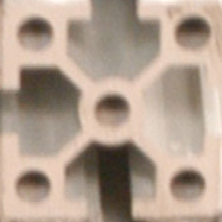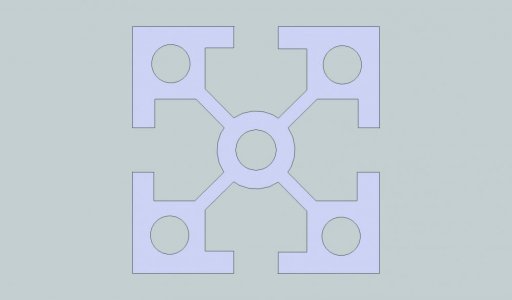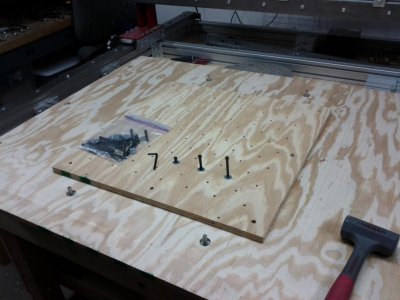- Joined
- Oct 13, 2012
- Messages
- 175
I have a CRP-4848 CNC router table that I built a couple of years ago. The table has performed well, but the one rough spot in the build was surfacing the table. I know that most folks just bolt down a 3/4" piece of plywood or MDF, then simply fix their work to the table surface using wood screws. This works fine for wood and where you are not too concerned with repeatability, but I would like more options. I would like to handle aluminum and plastic. I want to be able align the work parallel to the X and Y axis with some accuracy. I want the option of using clamps. The table size I'm trying to address is 57" x 54".
Most options I have looked at come at a substantial cost. A 5/8" cold rolled steel sheet can be had for $560 and I could drill and tap a hole pattern for tools and clamps. This is the most flexible for me, but the router would have to drill the holes - a problem since I have a 2.5Kw Chinese water cooled spindle with a minimum speed of 4K. T-Slots would work, but they are priced in the same range if spaced 2" apart and 60" long. I would love to have a aluminum surface with t-slots, but that's at the $1300 range.
As a short term option I created a 24"x24" tooling plate made out of 3/4" plywood and steel 1/4-20 steel wood anchors. it's anchored to to the table using a couple 3/8" steel dowels. This has worked fine until the 1/4-20 hex socket bolts I'm using want to get cross threaded and get stuck. Removing the munged anchor and bolt usually means destroying the anchor and the hole housing the anchor is shredded some. I'd like a larger, more robust, permanent solution.
I guess I'm looking for some options that don't cost an arm and a leg. The table is sitting idle until I can come up with a solution that doesn't cause frustration. I would welcome any ideas that folks have.
I have some 50mm x 50mm extruded aluminum t-slot stock (think 80-20 stuff). I could rip it in half if I could come up with a reliable way to do that. I have 9 pieces at 75" each, 18 pieces total after ripping. That's enough to cover the 54" x 57" surface by spacing the rails every 3" with a 1" wood spacer between them. Ripping and mounting the rails would be challenge. I would appreciate any ideas if this is even possible. The image below is the profile of the extruded aluminum stock.


Here's what I'm trying to surface.




Most options I have looked at come at a substantial cost. A 5/8" cold rolled steel sheet can be had for $560 and I could drill and tap a hole pattern for tools and clamps. This is the most flexible for me, but the router would have to drill the holes - a problem since I have a 2.5Kw Chinese water cooled spindle with a minimum speed of 4K. T-Slots would work, but they are priced in the same range if spaced 2" apart and 60" long. I would love to have a aluminum surface with t-slots, but that's at the $1300 range.
As a short term option I created a 24"x24" tooling plate made out of 3/4" plywood and steel 1/4-20 steel wood anchors. it's anchored to to the table using a couple 3/8" steel dowels. This has worked fine until the 1/4-20 hex socket bolts I'm using want to get cross threaded and get stuck. Removing the munged anchor and bolt usually means destroying the anchor and the hole housing the anchor is shredded some. I'd like a larger, more robust, permanent solution.
I guess I'm looking for some options that don't cost an arm and a leg. The table is sitting idle until I can come up with a solution that doesn't cause frustration. I would welcome any ideas that folks have.
I have some 50mm x 50mm extruded aluminum t-slot stock (think 80-20 stuff). I could rip it in half if I could come up with a reliable way to do that. I have 9 pieces at 75" each, 18 pieces total after ripping. That's enough to cover the 54" x 57" surface by spacing the rails every 3" with a 1" wood spacer between them. Ripping and mounting the rails would be challenge. I would appreciate any ideas if this is even possible. The image below is the profile of the extruded aluminum stock.


Here's what I'm trying to surface.





